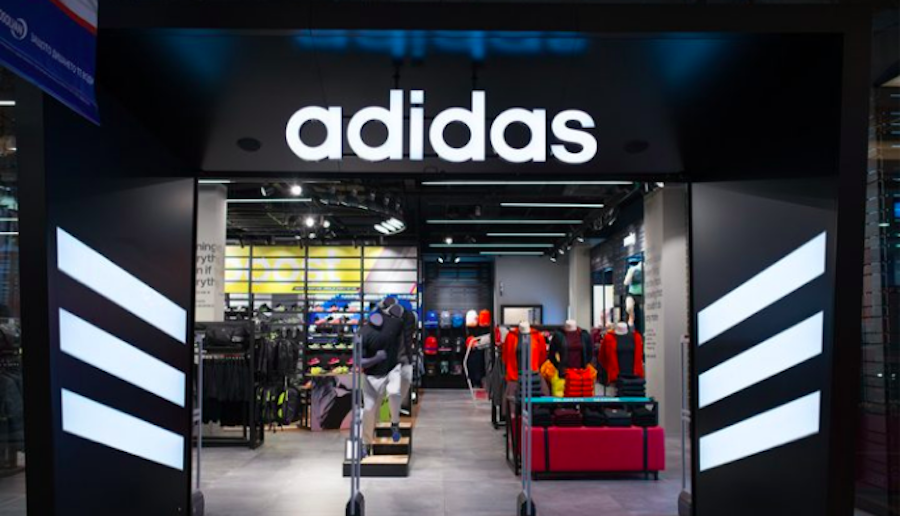Adidas AG’s earnings more than doubled in the second quarter, thanks to a boost from the World Cup and continued over-sized growth in North America and China.
Both earnings and sales topped analyst expectations. Adidas officials maintained their guidance for the full year as the company continues to invest in marketing and innovation to support growth platforms for both Adidas and Reebok.
The strongest growth regionally in the quarter came from Asia-Pacific, which was ahead 18.8 percent on a currency-neutral basis. More impressive was the 15.6 percent currency-neutral gain seen in North America.
While some reports noted that North America’s growth had slowed from a 21.1 percent increase seen in the first quarter, the 15.6 percent increase came on top of whopping gains of 25.8 percent in the second quarter of 2017 and 25.6 percent in the second quarter of 2016.
The gain erased fears that Adidas might have reverted to losing share to Nike in North America after Nike showed growth for the first time in four quarters in the U.S. in the company’s fourth quarter ended May 30. Nike’s currency-neutral sales in North America grew only 3 percent in that period.
Overall, revenues grew 10 percent currency-neutral to €5.26 billion ($6.06 bn) exceeding analyst’s target of €5.2 billion. In euro terms, sales increased 4.4 percent.
Net income from continuing operations jumped 20.5 percent to €418 million ($482 mm) beating analyst’s average expectations of €387 million.
Gross margins improved 220 basis points to 52.3 percent in part due to stronger-than-expected sales of football jersey and balls from the World Cup. Operating margin improved 120 basis points to 11.3 percent.
“We delivered another strong quarter on the back of a successful World Cup activation,” said Adidas CEO Kasper Rorsted. “Our profitable growth was once again driven by our strategic focus areas North America, Greater China and e-commerce, while we continued to invest into the desirability of our brands and the scalability of our business.”
On a conference call with analysts, Rorsted, as usual, began his presentation citing strengths and weaknesses seen in the quarter. On the strength side, he cited double-digit growth in North America, Asia Pacific, Latin America and Russia. Strong growth was seen in Sports Performance with double-digit increases in Training, Running and Football.
Around brand activation, he counted increased brand awareness around the World Cup and Parley Run For The Ocean initiative as wins. He also cited the strong profit improvement that came despite an acceleration of marketing investments by €100 million ($115 mm) to support the World Cup and other initiatives. He highlighted that the company’s focus on “quality growth” led to a bottom line “five times stronger” than top-line growth on a euro basis.
On the weaknesses side, the biggest issue cited was a slowdown in Western Europe, which saw flat currency-neutral growth in the second quarter.
Rorsted noted that the company had already warned that Western Europe was softening when the company released first-quarter results in May. The flat sales also came on top of growth of 15 percent on compound annual growth rate (CAGR) over the last three years in Adidas’ most-mature market. The region also improved its operating margin by 250 basis points over that three-year period.
But Rorsted also said the erosion was “more pronounced” than anticipated as some product storytelling and consumer activation “did not execute as well as in the past.” Changes have been made to Europe’s management structure, but Adidas expects to see similar softness in the second half in the region as the company takes a “disciplined approach” to rebuilding sustainable growth in the region.
Other areas of weakness in the quarter included operating expense leverage showing limited improvement as investments continue to be made back into the business and sales growth rates in the Sports Inspired business, normalizing after a “period of extraordinary growth.” The retail comp trend was also mixed with comps ahead mid-single digits globally, although positively impacted by the World Cup.
Overall, however, Rorsted said Adidas witnessed strong success all the company’s key strategic growth areas, including currency-neutral growth of 17 percent in North America, 27 percent in Greater China and 26 percent in e-commerce.
The World Cup, in which Adidas is a major sponsor, also paid off with Adidas content proving to be more visible across social media and with greater impact than any other competitor. Stadium advertising helped drive Adidas app downloads up to five times higher than average download rates, and the “Creativity is the Answer” campaign saw a strong response tied to the event.
On the commercial side, Adidas sold over 8 million jerseys during the World Cup to exceed 2014 levels. The gains came despite some “unexpected development” in the tournament, Roarsted said, referring to shortfalls for a few Adidas teams, including Germany, Brazil, Spain and Argentina.
Among brands, Adidas Brand revenues grew 11.9 percent currency-neutral in the quarter to €4.77 billion ($5.5 bn). Sales gained 6.1 percent in euro terms. Sport Performance expanded 16 percent currency-neutral, led by double-digit growth in Training, Running and Football. Sport Inspired segment sales were up 7 percent with “significant growth” in footwear and apparel.
Across categories, footwear growth for Adidas Brand accelerated to a double-digit increase in the second quarter, up from single digits in the first quarter.
Reebok brand sales declined 3 percent on a currency-neutral basis to €387 million ($446 mm) and were down 10.1 percent in euro terms. The currency-neutral decline was due to weakness in Western Europe. The bright spot for Reebok was 6 percent growth in North America that came despite a significant number of store closures in the past 12 to 18 months.
More importantly, gross margin for Reebok expanded 390 basis points to 44.9 percent, helped by further execution of the Muscle-Up turnaround program rolled out over the last two years. Said Rorsted, “So operationally we are making progress toward our task of returning Reebok to profitability by 2020.”
Online, the e-commerce revenue gain of 26 percent was driven by double-digit growth in all regions. The Adidas App has now been launched in 13 countries with more than 2.5 million downloads reached by the end of Q2.
Adidas delivered growth across all regions in the second quarter.
In North America, sales grew 15.6 percent on a currency-neutral basis to €1.08 billion ($1.25 bn) while gaining 6.8 percent in euro terms. The growth was driven by a 17 percent currency-neutral gain in Adidas Brand revenues. Adidas Brand’s growth was driven by Training, Running and Football. The Sports Performance side is particularly seeing “very good sell through growth” at key partner Dick’s Sporting Goods, Harm Ohlmeyer, CFO, said on the call. Reebok’s sales grew 6 percent despite store closings.
Gross margin in the North America region decreased 60 basis points to 40.8 percent. A better pricing mix was offset by less favorable channel and category mix. The region is still liquidating some excess merchandise that developed due to warehouse constraints caused by the opening of a new distribution center last year. Operating margin still expanded 380 basis points to 16.7 percent as operating leverage in the region offset the margin pressures.
In the Asia-Pacific region, sales grew 18.8 percent on a currency-neutral basis to €1.73 billion ($1.99 bn) and gained 15.4 percent in euro terms. Adidas Brand sales increased 19 percent on double-digit growth in Training, Running, Football and Sport-inspired styles. Reebok brand revenues were up 7 percent with double-digit growth in Training.
Gross margins in the Asia-Pacific region improved 30 basis points to 57.5 percent as better pricing, channel and category mix compensated for FX headwind. Operating margin added 100 basis points to 34.2 percent due to a higher gross margin and operating leverage.
Western Europe’ currency-neutral sales eased 0.1 percent to €1.42 billion ($1.64 bn) and were off 0.9 percent in euro terms. The performance was in line with expectations. Adidas Brand revenues were up 1 percent, driven by significant growth in Football on the back of World Cup activations. Reebok sales decreased 10 percent with both brands feeling a similar impact in the region. The performance came on top of strong gains in the prior year quarter, when Adidas Brand’s currency-neutral sales grew 18 percent and Reebok’s ran ahead 33 percent.
Gross margin in Western Europe in the latest quarter improved 330 basis points to 48.3 percent due to more favorable pricing mix. Ohlmeyer said the Western Europe region was ”really where we started with the quality growth initiatives” and the company remains committed to not driving growth at the expense of margin. Operating margins were up 0.8 basis points to 20.9 percent as the gross margin improvement was partly offset by brand investments.
Among other regions, Russia/CIS’ sales were up 14 percent on a currency-neutral basis, getting a “nice uplift” from the World Cup. Adidas saw a boost from on-site sales around the stadiums, and the gains came despite Adidas closing 180 stores in Russia in 2017 and another 50 so far in 2018.
Latin America sales were ahead 15 percent and benefited from Mexico’s and Argentina’s participation in the World Cup. Emerging Market revenues were up 1 percent on a currency-neutral basis.
Inventories were down 2 percent on a currency-neutral bais globally despite the top-line growth.
Adidas said the company was taking an impairment of €475 million ($548 mm) related to the Reebok trademark that will lead to a restatement of 2016 results. The restatement followed a routine review by the German Financial Reporting Enforcement Panel that found an impairment test conducted in 2016 over-valued the book value of Reebok’s trademark given the company’s performance from 2006 to 2016. Adidas bought the Reebok brand in 2005. Adidas said the accounting restatement has no impact on the company’s cash position, the company’s 2018 income and cash flow statements as well as its short- and long-term guidance.
Adidas reiterated guidance for 2018:
- Sales are expected to increase at a rate of around 10 percent on a currency-neutral basis, driven by double-digit growth in North America and Asia-Pacific.
- Gross margin is expected to increase up to 0.3 percentage points to a level of up to 50.7 percent. More favorable pricing, channel and regional mix is expected to offset the negative impact from unfavorable currency movements as well as higher input costs.
- Operating margin is forecast to improve between 0.5 and 0.7 percentage points to a level between 10.3 percent and 10.5 percent.
- Net income from continuing operations is projected to increase to a level between €1.615 billion and €1.675 billion, reflecting a year-over-year increase of between 13 percent and 17 percent.
Rorsted cited a number of levers to drive top-line growth in the quarters ahead. They include building on recently-successful streetwear collaborations around the company’s Ultra Boost franchise. The next generation of Ultra Boost arrives in early 2019 with a goal to reach €1 billion in sales.
In Football, Adidas will build on the latest updates to the company’s four key franchises: X, Predator, Nemesis and Copa–introduced at the World Cup. The Adidas P.O.D. System, featuring Boost foam in the heel and EVA cushioning in the forefoot, is expected to drive Sports-influenced footwear sales with creative workshops being established in London and Brooklyn to support activation. In technical running, the Solar franchise was successfully launched in May and will expand to diverse price points in the second half.
Adidas will extend the company’s collaboration with start-up Carbon with a goal of bringing mass production of 3D printed shoes to the marketplace. Adidas also still has a goal of releasing 5 million pairs of Parley footwear in 2018. Each pair of Parley shoes prevents 11 plastic bottles from entering in the world’s oceans. A million pieces of apparel featuring Parley are also expected to be sold this year.
Reaching into archives will also continue to be a source of growth for both Reebok and Adidas, such as Adidas Brand’s recent launch of the Continental 80.
Rorsted cautioned that Adidas continues to focus on sustainable growth for both Adidas Brand and Reebok. He said, “For 2018 we plan to have the right balance between market share improvement and margin improvement, and that is really the essence of what we’re doing with our company.”
Photo courtesy Adidas
















